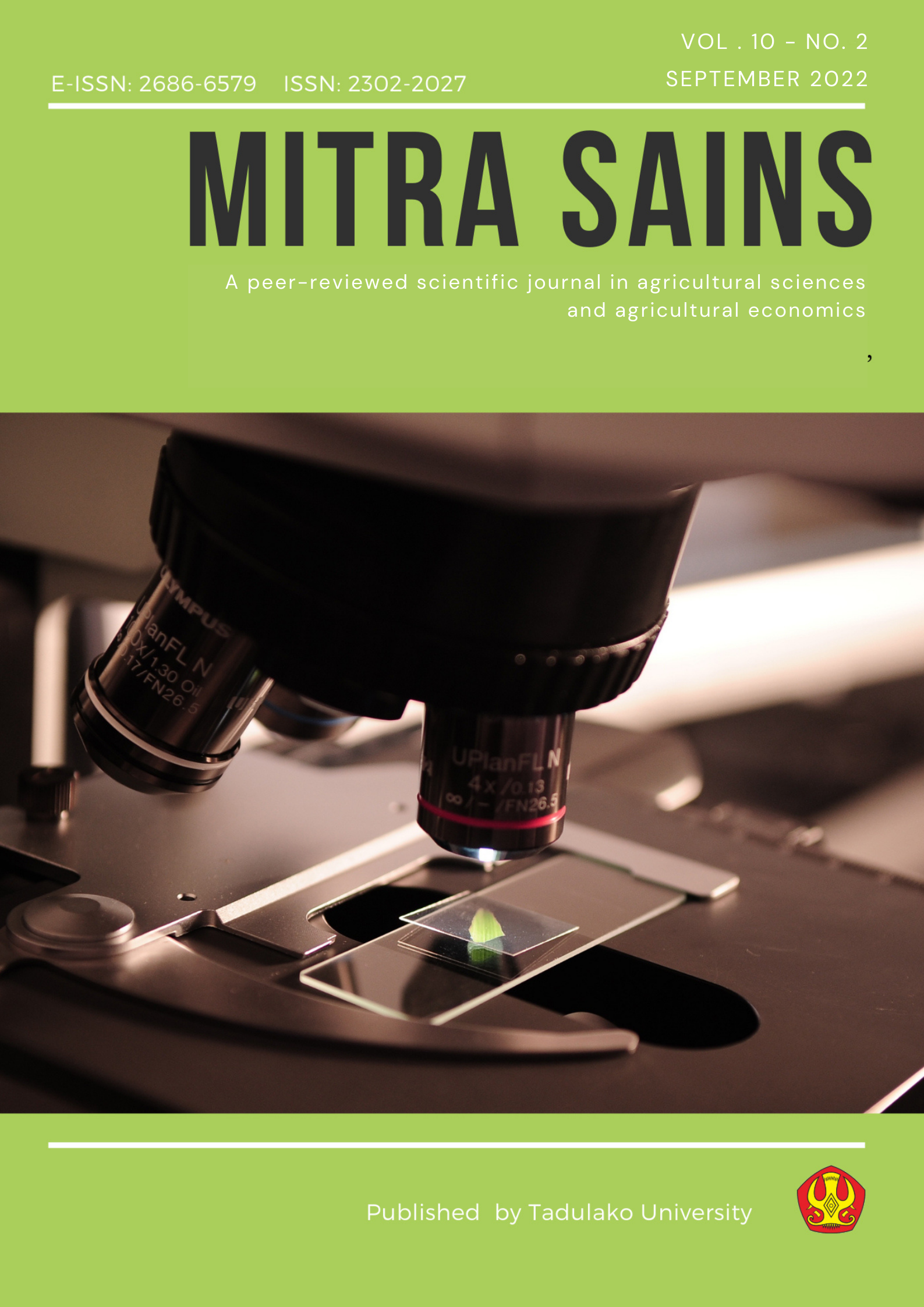Biomass and Carbon Stock of Candlenut Stand (Aleurites moluccana Willd)
Abstract
This research was conducted to determine the biomass and carbon reserves of candlenut stands (Aleurites moluccana Willd), determine the effect of stand age on increasing biomass and carbon reserves, see the level of soil health and determine the relationship between stands. This type of research is descriptive which was carried out through surveys and data analysis using SPSS. The research results show that stand age has a positive effect on the amount of biomass and carbon stock produced. In 6 year old stands the average biomass = 12.23 tonnes/ha, and carbon 5.72 tonnes/ha, in 10 year old stands the average biomass = 23.23 tonnes/ha and carbon 10.87 tonnes/ha, 15 year old stands had an average biomass = 35.07 tons/ha and carbon 16.45 tons/ha. The correlation between age and biomass obtained by the equation The higher the age, the larger the stand diameter so that more biomass and carbon are produced. In addition, the high content of c-organics in the soil can maintain soil health levels.
References
Arief, A. 2005. Hutan dan Kehutanan. Penerbit Kanisius. Yogyakarta.
Brown S. 1997. Estimating biomass and biomass change of tropical forest. A Primer. USA: FAO. Forestry Paper. 134: 10-13
Badan Standardisasi Nasional (BSN). 2011. Pengukuran dan Penghitungan Cadangan Karbon. Pengukuran Lapangan untuk Penaksiran Cadangan Karbon Hutan (Ground Based Forest Carbon Accounting). Buku Badan Standardisasi Nasional. Jakarta. 16. Hal 1-28.
Cairns, Michael A., Sandra Brown, Eileen H. Helmer, Greg A. Baumgardner. 1997. Root biomass allocation in the world's upland forests. Oecologia. 111:1 -11
Departemen Kehutanan. (1997). Strategi Nasional Pengelolaan Mangrove di Indonesia. Jilid 1: Mangrove di Indonesia: Status Sekarang. Jakarta: Departemen Kehutanan
Djaenudin D, Suryandari EV, Suka AP. 2015. Strategi penurunan risiko kegagalan implementasi pengurangan emisi dari deforestrasi dan degradasi hutan : studi kasus di Merang, Provinsi Sumatera Selatan. Jurnal Analisis Kebijakan Kehutanan. 12(2):173-188.
Hairiah, K. 2007. Pengukuran Karbon Tersimpan di Berbagai Macam Penggunaan Lahan. Bogor. World Agroforestry Centre, ICRAF Southeast Asia. Hal 1-21.
Hairiah, K. 2011. Pengukuran Cadangan Karbon dari Tingkat Lahan ke Bentang Lahan. Bogor. World Agroforestry Centre.
Hairiah, K. 1999. Methods for sampling above and belowground organic pools. IC-SEA Report No.6/GCTE Working Document No. 28. Bogor. BIOTROP-GCTE/IC-SEA.
Lukito M, Rohmatiah A. 2013. Estimasi biomassa dan karbon tanaman jati umur 5 tahun (Kasus Kawasan Hutan Tanaman Jati Unggul Nusantara (JUN) Desa Krowe, Kecamatan Lembeyan Kabupaten Magetan). Agritek. 14(1):123.
Moebius-Clune, B. N. 2017. Comprehensive Assessment of Soil Health, Third Edition. New York: Cornell University.
Siregar, CA., Dharmawan, WS. 2011. Stok karbon tegakan hutan alam dipterokarpa di PT. Sarpatim, Kalimantan Tengah. Jurnal Penelitian Hutan dan Konservasi Alam. 8 (4):337-348.
Yahmani, A. 2013. Studi Kandungan Karbon Pada Hutan Alam Sekunder di Hutan Pendidikan Mandiangin. Jurnal Hutan Tropis Borneo. 1 (1):85-91.
Rusdiana, O., Lubis, RS. 2012. Pendugaan Korelasi antara Karakteristik Tanah terhadap Cadangan Karbon pada Hutan Sekunder. Jurnal Silvikultur Tropika. 3 (1):14-21.
Sedjarawan W, Akhbar, Ida Arianingsih. 2014. Biomassa dan Karbon Pohon di atas Permukaan Tanah di Tepi Jalan Taman Nasional Lore Lindu (Studi Kasus Desa Sedoa Kecamatan Lore Utara Kabupaten Poso). Warta Rimba. 2(2):105-111.

Copyright (c) 2022 Erika Erika, Wardah Wardah, Naharuddin Naharuddin

This work is licensed under a Creative Commons Attribution-ShareAlike 4.0 International License.





